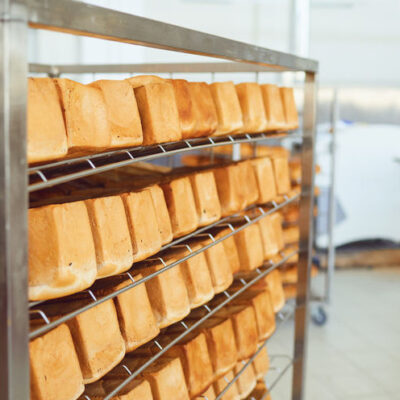Origin
Ethoxylated mono- and diglycerides are made from glycerol esters of stearic and palmitic acid.
Function
EMG and EDG are used in baked products, toppings, whiteners, non-standardized frozen desserts and icings. EMG functions as a great dough conditioner in baked goods and as an emulsifier in coffee whiteners, icings, cake batters, and frozen desserts. EMG and EDG also contribute to freeze–thaw stability and overrun in whipped toppings.1,2
Commercial production
The reaction of mono- and diglycerides from edible vegetable fats with ethylene oxide under pressure yield ethoxylated mono- and diglycerides.
Stoichiometry of ethoxylated monoglycerides preparation requires combining one part of mono- and diglycerides with approximately 20 parts of ethylene oxide. The ethylene oxide reacts with the free OH- group of glycerin and with itself to form a hydrophilic chain. The end product is an oily liquid or paste.
Application
Ethoxylated mono- and diglycerides are effective emulsifiers used in the baking industry to improve rheological or handling properties of dough, loaf volume and texture of bread. They have very little crumb softening effect.
Commercial preparations of ethoxylated mono- and diglycerides contain low saponification values (65–75) and low acid values (2.0% max) indicating long fatty acid chains and few carboxylic acid moieties.2
Considerations when using ethoxylated mono- and diglycerides
- EMG is a very good dough strengthener and provides higher tolerance to over-proofing. It also helps the dough expand during the initial stages of baking (oven-spring).
- EMGs provide excellent improvement in loaf volume and dough strength, but have no effect on crumb softness or grain character. It is almost always used in combination with regular monoglycerides.
- Usually added to bread formulations at levels of 0.15 to 0.4%. Overdosing causes collapse during baking as the dough undergoes excessive expansion which causes the foam structure to collapse.
- Good for whole grain and other high absorption pan breads.
- Softness varies with fatty acid chains (e.g. aliphatic chain length, saturation/unsaturation).
- Itsnon-ionic character and intermediate polarity or HLB value make it soluble in water and partially soluble in oil.
Comparison between ethoxylated monoglycerides (EMG) and ethoxylated diglycerides (EDG)
| Product | HLB value | Dough strengthening (gluten-interacting) | Crumb softening (starch-complexing) |
| Ethoxylated monoglycerides (EMG) | 10 – 12
(O/W emulsifiers) |
High | (Low) Less than mono- and diglycerides |
| Ethoxylated diglycerides (EDG) | Lower than 10 | Medium | Very low |
FDA regulation
According to 21 CFR Sec. 172.834, ethoxylated mono- and diglycerides are regulated food additives (emulsifiers) that are permitted for direct addition to food for human consumption. EMG and EDG can be used in bread formulation at levels of 0.5% max (based on flour weight).
References
- Kamel, B.S. “Emulsifiers.” Food Additive User’s Handbook, SPRINGER SCIENCE+BUSINESS MEDIA, LLC, 1991, pp. 169–201.
- Poirier, C.A. “Emulsifiers.” Food Additives Data Book, 2nd edition, Blackwell Publishing Ltd., 2011, p. 330.
- U.S. Food and Drug Administration, CFR – Code of Federal Regulations Title 21, Part 172 — Food Additives Permitted For Direct Addition to Food For Human Consumption, https://www.accessdata.fda.gov/scripts/cdrh/cfdocs/cfcfr/CFRSearch.cfm?fr=172.834, Accessed 17 August 2020.

